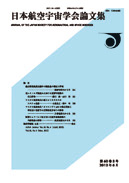巻号一覧

32 巻, 368 号
選択された号の論文の7件中1~7を表示しています
- |<
- <
- 1
- >
- >|
-
田畑 浄治1984 年 32 巻 368 号 p. 483-490
発行日: 1984/09/05
公開日: 2009/05/25
ジャーナル フリーPDF形式でダウンロード (3752K) -
木戸 敬久1984 年 32 巻 368 号 p. 491-502
発行日: 1984/09/05
公開日: 2009/05/25
ジャーナル フリーPDF形式でダウンロード (4493K) -
片野 忠夫1984 年 32 巻 368 号 p. 503-510
発行日: 1984/09/05
公開日: 2009/05/25
ジャーナル フリーPDF形式でダウンロード (3661K) -
木村 雄吉, 西尾 正富, 小竹 睦夫1984 年 32 巻 368 号 p. 511-517
発行日: 1984/09/05
公開日: 2009/05/25
ジャーナル フリーThe steady hypersonic flow around a slender conical flat-top wing-body has been solved by applying the equivalence principle, which is the theory that the problem of steady hypersonic flow past a slender body is equivalent to the problem of unsteady flow in a plane. Then, the problem of this conical flat-top wing-body becomes into the problem of an expanding motion of a hemi-cylinder with a plane wing. The flowfield of this expanding body has successfully been solved by means of a conformal transformation and a superposition technique. Moreover, the other problems of small angles of attack, vortices, shock shape etc. have been also solved. As for the experimental investigation, the flow around the expanding body has been visualized. The experimental results agree well with the theoretical ones.抄録全体を表示PDF形式でダウンロード (3355K) -
岩崎 松之助, 渡辺 桂吾1984 年 32 巻 368 号 p. 518-525
発行日: 1984/09/05
公開日: 2009/05/25
ジャーナル フリーThe aerodynamic performance of a four-bladed propeller at static condition is calculated by a vortex theory on the assumption of infinite number of blades in consideration of the slipstream deformation. The thrust and torque distributions along blades are obtained by measuring the static pressure over the blade surface. The agreement of the numerical results with the experimental ones is fairly good. Some informations about the behavior of the slipstream are given. The application of the present method to the estimation of helicopter rotor performance at hovering state also shows tolerable result.抄録全体を表示PDF形式でダウンロード (2213K) -
限界高度比距離特性船木 功水1984 年 32 巻 368 号 p. 525-532
発行日: 1984/09/05
公開日: 2009/05/25
ジャーナル フリーThis paper presents a study on the flight range of a vehicle propelled by a ramjet engine from a view point of the vehicle-engine design trends. Of our interest is to know how far it can fly for a given amount of fuel, which strictly depends on the selection of fundamental design parameters of the vehicle-engine system and the component performance characteristics as well. A systematic parametric study was conducted to reveal the performance variable effects on the steady state flight range, such as the flight Mach number, altitude, lifting force, drag force, vehicle frontal projected areas, vehicle weight, pressure recovery at the inlet, energy density of fuel and so on. It was found that the flight altitude is the most predominant factor to determine the flight range and the higher altitude results in the longer flight distance because of the lower density effects. However, there exists a limit in the flight range, called the aerodynamic ceiling altitude, at which the vehicle lifting force must at least su port the vehicle weight, consequently determining the longest possible flight range attained. The aerodynamic ceiling altitude was found to increase almost linearly with respect to the flight Mach number up to the design value but remain nearly constant above it because of the constant mass flow capture area at the engine inlet. Another limitation is due to the combustion instability as discussed in Part 1 of the present paper which mostly restricts the flight range at the flight Mach numbers below the design value, although it depends on the vehicle lift-weight ratio. The aerodynamic ceiling altitude, therefore, limits the flight range at the higher flight Mach numbers than the design in most of the cases.抄録全体を表示PDF形式でダウンロード (867K) -
小林 秀之, 中川 正, 西田 迪雄1984 年 32 巻 368 号 p. 533-538
発行日: 1984/09/05
公開日: 2009/05/25
ジャーナル フリーLaser interferometry using Wollaston prisms has been applied to density measurements in freely expanding flows issuing from a sonic orifice. The radially resolved densities have been determined by means of an Abel inversion under the assumption of an axisymmetric flow. Thus determined densities have been compared with the predicted ones from the formula for a Mach number in the free jets proposed by Ashkenas and Sherman. The comparison shows a fairly good agreement between the experimental and predicted results in the region surrounded by the barrel shock and Mach disk, except for the flowfield near the orifice.抄録全体を表示PDF形式でダウンロード (326K)
- |<
- <
- 1
- >
- >|